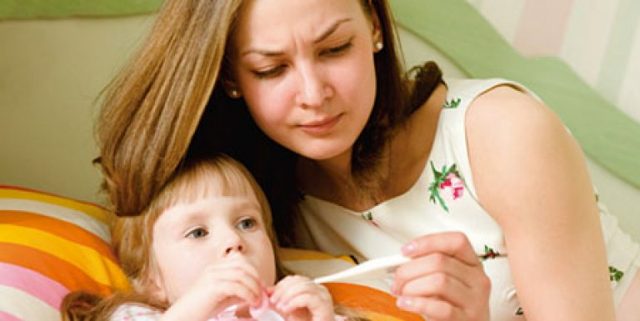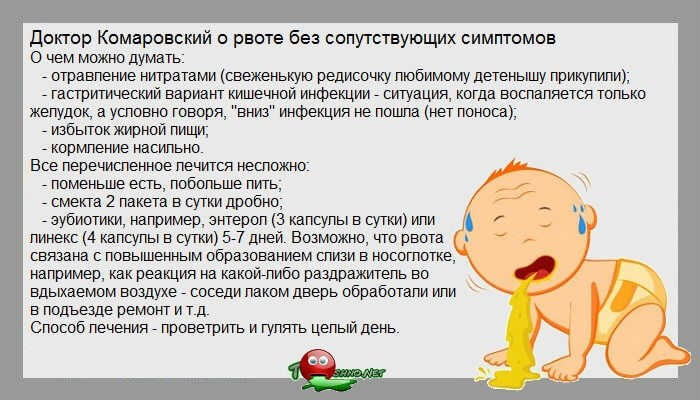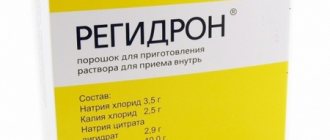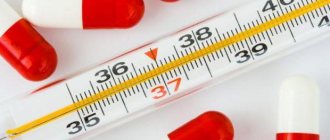Causes of the painful condition
If a child vomits and the temperature rises, this means that pathological processes are occurring in the body, to which the immune system reacts accordingly. Vomiting prevents pathogenic microorganisms from moving further, and temperature helps destroy them.
Fever and vomiting in a child can accompany the following diseases and pathological conditions:
- inflammatory processes in internal organs;
- acute conditions requiring immediate surgical intervention, such as an attack of appendicitis;
- intestinal infections (salmonellosis, enterovirus, cholera, rotavirus, dysentery);
- ARVI, influenza;
- pneumonia;
- poisoning by food or chemicals, medications (intoxication may involve low fever and vomiting);
- exacerbation of colitis, gastritis or hepatitis;
- hernia.
A state of fever with vomiting can occur with disorders of a psychogenic or neurological nature.
Vomiting and fever without diarrhea
The reasons why a child is throwing up can be determined by the presence or absence of accompanying symptoms. Vomiting and high fever in a child without diarrhea most often indicate colds. This happens due to the incompletely formed digestive tract and the fact that thermoregulation in the oral cavity is unstable.
A gag reflex without diarrhea in a child can be triggered by cough syndrome and sputum entering the esophagus. In this case, the urge to vomit will be one-time, and after it comes relief.
Vomiting and fever in a child without diarrhea often occur with:
- teething;
- intestinal obstruction;
- acute inflammation of the digestive tract;
- meningitis;
- reactions to taking certain medications;
- increased acetone in the blood;
- pyloric stenosis is a condition in which the valve located between the duodenum and the stomach thickens, making it difficult to digest food.
Sometimes, due to psychogenic factors, children do not have diarrhea, but develop a fever with an attack of nausea. Severe fear or stress affects the centers of the nervous system responsible for thermoregulation. They also cause spasms in the muscles of the gastrointestinal tract.
Temperature rose after vomiting
If a child's vomiting and fever do not occur simultaneously, but follow each other, this may be a symptom:
- Pneumonia, tonsillitis, flu, meningitis. Other associated symptoms: headaches, muscle spasms and joint aches, runny nose.
- Diseases of the children's age group: rubella, scarlet fever, measles.
- Inflammation of the gastrointestinal tract.
- Increasing acetone. In this case, the child will clearly smell acetone in the mouth.
If nausea occurs first and then fever develops, this may be a sign of acute surgical conditions. In such situations, there is pain in the abdominal area.
Temperature 38
Vomiting and a temperature of +38°C are most often a manifestation of acetonemia, which is accompanied by dehydration and general intoxication of the body. Other signs of this pathological condition:
- dry mucous membranes;
- general weakness;
- pale skin;
- redness of the cheeks.
The increase in acetone is affected by fatty foods, chocolate, juices, and canned goods. Nausea and temperature up to +38°C can also occur with colds or food poisoning. In this case, first vomiting occurs, then the child has a fever.
Temperature 37-37.5
In a child, vomiting and a temperature of +37°C without diarrhea are characteristic of pathologies of the digestive tract. A slight increase in temperature is possible with intoxication or intestinal infection occurring in a mild or initial stage.
Vomiting in a child with a temperature of +37°C is often a response to nervous tension or stress. These conditions are not dangerous to health.
Temperature 39
Intestinal infections leading to dehydration can cause severe fever (temperature +39°C). A high temperature during vomiting in a child may indicate acute surgical conditions: appendicitis, strangulated hernia, intestinal obstruction. Vomiting is most often one-time in nature, the temperature rises suddenly. Other provoking factors: diphtheria, sore throat, influenza.
How to treat vomiting and fever in a child without diarrhea
How to help a child depends on the symptoms and the causes of the disease. If vomiting occurs at least 6 times a day, and the child can drink on his own, then you should definitely give him plenty of water to prevent dehydration.

Severe vomiting, diarrhea, high fever are signs of intoxication. In this case, the main help for the child is to quickly contact a specialist. Dehydration with such symptoms, even if you drink a lot of fluids, will occur quickly. The main symptoms of dehydration are considered to be:
- the appearance of dry areas of skin;
- the child begins to lose weight quickly;
- in babies under the age of one year, the fontanel may become retracted;
- urination occurs less than 4 times a day.
This condition is especially dangerous for newborns. They experience a narrowing of the stomach, as a result of which food stops entering the intestines.

In all cases, you should immediately consult a doctor for help. Urgent treatment is recommended in the following cases:
- a head injury, which is accompanied by vomiting and an increase in body temperature;
- vomiting repeated several times a day;
- abdominal pain;
- if the child is unable to drink water on his own;
- body temperature remains above 39 degrees and is not reduced by medications to reduce body temperature.
If the symptoms are prolonged, a visit to the doctor is required as soon as possible. The main thing in this condition is to drink. Moreover, you need to follow some rules.
If the child is older, inexperienced parents do not always understand how to help him. This is especially true in cases where there is vomiting and fever in a child, without diarrhea. As a rule, in such cases they often refer to rotavirus infection, but is this really so?
We recommend reading: Diphenhydramine - instructions for use, analogues, indications
Additional symptoms
Nausea, vomiting, and fever in a child are not the only signs of pathological conditions. Depending on what caused the fever with vomiting, accompanying symptoms will be present:
- prolonged headaches of varying intensity;
- attacks of dizziness;
- general weakness, apathy, drowsiness;
- pain and aching feeling in the muscles;
- crying and moodiness;
- throwing the head back;
- pale skin;
- profuse sweating;
- loss of appetite or complete refusal to eat;
- cough;
- painful sensations in the throat.
For viral infections and colds, the main symptom is rhinitis.
Vomiting and diarrhea (diarrhea)
If diarrhea and nausea are added to a child’s fever, in most cases this indicates the development of intestinal infections:
- enterovirus;
- salmonellosis;
- rotavirus;
- dysentery;
- cholera;
- Escherichiosis.
The temperature in these pathologies increases to +39...+40°C, vomiting becomes more frequent, stool is greenish in color, and may contain mucus. If a diagnosis is not made in a timely manner and treatment is not carried out, serious consequences are possible.
Rotavirus infections in most cases occur in children aged 1.5-2 years. Routes of infection:
- contact and household;
- through dirty hands;
- due to the use of low-quality, unboiled water.
Signs of rotavirus infection as it manifests:
- general weakness, drowsiness;
- sore throat;
- runny nose;
- prolonged headaches;
- gradual increase in heat;
- attacks of nausea;
- gagging;
- pain in the stomach;
- diarrhea.
If vomiting with diarrhea is present at a high temperature, this set of symptoms may indicate poisoning with chemicals, poisons, low-quality products and medications.
In addition to vomiting and loose stools, other symptoms occur: chills, sharp abdominal pain, pale skin. After vomiting or diarrhea, a feeling of relief occurs, because toxic substances are removed from the body. Therefore, there is no need to stop vomiting until doctors make an accurate diagnosis.
In case of headache
If a child has a fever and headaches after vomiting, most often these symptoms indicate food poisoning. First, nausea and vomiting occur, and only then fever and pain in the head appear. The most dangerous diseases that cause such symptoms are:
- Encephalitis is a disease that affects the central nervous system. Occurs as a result of a tick bite or after contact with the products of infected animals.
- Meningitis is an inflammatory process in the brain or spinal cord. In addition to fever and headache, there are signs such as cramps, muscle numbness, chills, and fear of bright light.
- Poliomyelitis is a disease that affects the nervous system. Leads to paralysis, and in severe cases, death.
Repeated vomiting with prolonged pain in the head and fever may be a sign of the development of thermoneurosis. This pathology is characterized by spasm of blood vessels, which entails a violation of thermoregulation. All 3 signs also appear due to stomach flu.
Runny nose, snot
When a child's vomiting is combined with fever and runny nose, the first disease that is suspected is nasopharyngitis. This is an inflammation of the mucous membranes of the nasal cavity and larynx. Patients have a dry, irritating cough and a stuffy nose. Vomiting occurs due to mucus from the sinuses draining into the throat.
Cough and vomiting with fever
Fever and cough, accompanied by nausea and vomiting, indicate colds. Vomiting in this case does not pose any health hazard. It occurs as a reaction of the child’s body to high temperature. Cough, fever, vomiting without diarrhea are signs of:
- flu;
- bronchitis;
- ARVI;
- tracheitis;
- tonsillitis;
- pleurisy;
- whooping cough;
- pneumonia;
- rhinopharyngitis.
Vomiting occurs due to the fact that phlegm enters the stomach, and nausea is provoked by a strong cough. In this case, you need to deal with coughing rather than vomiting. As soon as it decreases, the urge to vomit will pass.
Red throat and sore
Sore throat when swallowing, fever, vomiting are symptoms of diseases of a bacterial and viral nature: sore throat, scarlet fever or pharyngitis. With such diseases, an increase in temperature to +39°C is the norm.
In addition to viral and bacterial diseases, diphtheria manifests itself as redness and pain in the throat. Its distinctive signs: swelling in the walls of the throat, low blood pressure. Diphtheria is a serious disease that requires immediate hospitalization of the patient.
If vomiting is accompanied by weakness
If general weakness is accompanied by fever without diarrhea and other pronounced symptoms, most likely we are talking about various intestinal diseases or pathologies of the respiratory tract. In addition to weakness, apathy and drowsiness, there will be signs of dehydration: a decrease in urine output and a decrease in the frequency of urination, dry mucous membranes.
The greatest danger is if the child remains in a semi-conscious state. This symptom may indicate a traumatic brain injury or severe dehydration.
Vomiting bile, yellow vomit
Nausea at fever may be accompanied by the release of yellow vomit. This symptom indicates diseases of the gallbladder or bile ducts. Such pathologies include:
- viral type hepatitis;
- exacerbation of gastritis;
- pancreatitis;
- intestinal obstruction.
Based on the temperature readings, you can roughly understand what triggered the yellow vomit. In the case of gallstones or acute cholecystitis, the temperature will rise to + 39…+ 40°C.
If yellow vomit is accompanied by diarrhea, this most likely indicates an intestinal infection.
Fever, vomiting and skin rash
If a skin rash is accompanied by fever and vomiting, this may indicate:
- diseases of viral origin (enterovirus infection, chickenpox, measles, rubella, smallpox);
- bacterial diseases (scarlet fever);
- infections of meningococcal origin (blood poisoning or meningitis).
A rash may occur if a child is allergic to food, household chemicals or other irritants. But often fever with frequent vomiting can provoke the appearance of rashes.
If vomiting at sea
The appearance of vomiting in combination with fever on a sea holiday are symptoms that require urgent medical attention. During a holiday on the coast, the risk of food poisoning, in particular seafood, increases, which can lead to serious consequences. Intestinal infections are also common at sea. In case of poisoning, the child’s condition can be alleviated by gastric lavage and drinking plenty of fluids.
Most often, during the summer holidays, children are exposed to sunstroke or heatstroke. These conditions are accompanied by nausea, vomiting, and fever up to +38°C. Other accompanying symptoms: rapid breathing, drowsiness, severe fatigue to the point of loss of strength. With sunstroke or heatstroke, there is no diarrhea.
Body temperature and nausea in the first 12 weeks of pregnancy
Hormonal changes
The main cause of nausea and increased body temperature in the first trimester of pregnancy is hormonal changes in a woman’s body. Due to the increase in the amount of progesterone produced, which is responsible for maintaining pregnancy, there is a slight increase in body temperature.
An “interesting position” weakens a woman’s immunity, which can lead to various diseases caused by viruses and bacteria.
Pregnant women must follow these rules:
- If possible, limit your presence in crowded places;
- observe personal hygiene more carefully;
Development of viral diseases
Acute respiratory viral infection or influenza during pregnancy also leads to symptoms of nausea and fever. Complications from them, one of which is pyelonephritis, lead to more serious consequences.
Pyelonephritis is a disease that affects many pregnant women.
Its symptoms:
- pain in the lumbar region, radiating to the thigh or groin;
- frequent and painful urination;
- weakness;
- headache;
- nausea;
- increase in body temperature.
Intestinal infection
Another trouble that often occurs during pregnancy is an intestinal infection.
It can also cause pain:
- loose and frequent stools;
- pain in the stomach;
- fever and nausea are symptoms that indicate this disease should be suspected.
Diagnostics and tests to clarify the diagnosis
To make a diagnosis, a comprehensive examination is required, including:
- Blood analysis. Biological material is taken from a finger. The study helps to identify the presence of inflammatory processes in the body.
- Biochemical analysis of venous blood shows the general condition of the body.
- Analysis of morning urine to determine protein and leukocytes. These indicators determine the degree and severity of inflammation. Based on the results of the study, the dosage of medications is selected.
- Stool examination reveals the presence of bacteria or viruses, fungal infections. Shows the presence or absence of helminths, which can also cause fever and vomiting if there are too many parasites.
- Ultrasound examination - shows the condition of internal organs, in particular the intestines, gallbladder and bile ducts, liver and pancreas.
- Intestinal endoscopy - shows the condition of the intestines and its mucous membranes.
- Gastric gastroscopy - performed to exclude gastritis and ulcerative formations.
In severe cases, if it is not possible to quickly make a diagnosis and the body does not respond to the prescribed treatment, magnetic resonance imaging of the abdominal organs or the whole body is performed.

How to treat a child depending on age
Treatment for fever after vomiting or a combination of both symptoms is selected depending on the reasons that led to this condition and the age of the child.
Babies 4, 5, 6, 7, 8, 9, 10, 11 months
When vomiting occurs, the first thing to do is to give the body a vertical position and make sure that the baby does not roll over onto his back. Otherwise, there is a risk that vomit will enter the respiratory tract.
There is no need to stop breastfeeding. Considering that vomiting causes dehydration, the child will need to be provided with frequent drinks in small portions - fluid should be given every 5 minutes, 1-2 tsp.
There is no need to lower the temperature until it rises above +38.5°C. It is prohibited to give any medications; medications are prescribed only by a doctor.
Child 1, 2, 3 years old
Fever and vomiting in a one-year-old child and children under 3 years of age require immediate action to prevent dehydration. To improve your general condition before confirming the diagnosis, you must:
- Give yourself a saline solution prepared or purchased at a pharmacy to drink.
- Provide plenty of fluids - 3 tsp every 5 minutes. water. It is impossible to pour in a large amount of liquid at once, as this may intensify vomiting.
- Adjust your diet. The basis of nutrition is crackers, porridge with a viscous consistency. Feed only when hunger occurs. You can't force feed.
It is forbidden to give any drugs - antipyretics, antiemetics, antibacterials. It is not worth reducing the temperature below +38.5°C.
Preschooler 4, 5, 6 years old
In case of prolonged vomiting and high fever, if they do not go away within 24 hours, you must consult a doctor for a diagnosis and prescribing the correct treatment. If the temperature is too high, it is recommended to bring it down by wiping the body with an alcohol solution. Be sure to follow the correct drinking regime: every 5 minutes, 2 tbsp. l. water.
Measures to alleviate the general condition are the same as for children from 1 to 3 years old. Cases that require calling an ambulance:
- suspicion of poisoning of a child with poisons or chemicals;
- vomiting continues for more than a day and does not go away;
- there is blood in the vomit;
- nausea and vomiting occurred after injury;
- there is no way to give the child something to drink, because the water he drinks is immediately regurgitated;
- presence of seizures;
- intense pain in the stomach and head;
- fainting.
In such situations, the child must be immediately taken to the hospital; giving him any drugs is strictly prohibited.
Schoolboy 7, 8, 9, 10, 11, 12, 13, 14 years old
It is easier to determine why a student has a fever with vomiting, since he is already able to describe his condition, answer what foods or substances he recently consumed. It is necessary to call an ambulance in case of severe pain, persistent vomiting, or prolonged absence of urination.
If the condition is not critical, the following measures are taken:
- ensuring plenty of fluids;
- taking water-salt solutions (Hidrovit or Regidron);
- use of enterosorbents (Smecta, activated carbon);
- taking probiotics (Bifiform, Linexa).
Antispasmodics can be given to a schoolchild only when absolutely necessary, as they blur the symptomatic picture, making diagnosis difficult. The temperature does not drop to +39°C, so as not to interfere with the immune system’s ability to independently fight bacterial microorganisms.
Folk remedies and medicines to make you feel better
You can only give medications on your own to prevent dehydration:
- Sorbents. Helps cleanse the digestive system of pathogens and their waste products and toxic substances. Sorbents include activated carbon, Polysorb.
- Glucose-salt. They are taken immediately after the complete cessation of vomiting in order to restore the water-salt balance. Recommended: Hydrovit, Regidron.
- Antiemetics. Helps stop nausea and vomiting. This category includes Motilium, Cerucal or Domperidone.
- Complex action. They help relieve the main signs of illness and restore intestinal function. These include Smecta, Linex, Hilak Forte.
In case of fever, it is necessary to take antipyretic drugs intended for children:
- Nurofen;
- Panadol;
- Calpol.
Antibacterial or antiviral medications are prescribed only by a pediatrician. They are prescribed if nausea with fever is caused by infections in the intestines.
In addition to drug therapy, when a child vomits, you can give traditional medicine, which has a more gentle effect on the body. But such drugs, like medications, have indications and contraindications, and can also cause side effects, so before treating a child with them, you need to consult a specialist. Recommended folk recipes:
- Peppermint in the amount of 1 tbsp. l. pour 200 ml of hot water, but not boiling water. Brew the herb in a thermos, which is tightly closed with a lid. The decoction is infused for 2 hours. Dosage - 1 tbsp. l. with every attack of nausea.
- Melissa decoction is prepared by analogy with the first recipe. Take 1 tsp. up to 4 times a day.
- Valerian root is crushed, 1 tsp. pour 200 ml of water. The liquid is brought to a boil and boiled for 10 minutes. After cooling, strain through cheesecloth. Take 3 tsp immediately when vomiting occurs.
- 1 tsp. Dill seeds are poured with 1 cup of boiling water. Boil for 5 minutes. After complete cooling, filter. Drink 2 tsp when the urge to vomit appears.
Traditional methods that help normalize temperature:
- Raspberries have an antipyretic and diuretic effect, helping the immune system fight viruses. You can eat both fresh berries and raspberry jam, which is added to tea.
- Rubbing helps relieve fever without taking antipyretic medications. A solution of vinegar or alcohol is used for rubbing. A waffle towel is soaked with the selected product and the body is rubbed for 2-4 minutes, no more. If necessary, the procedure is repeated after some time.
- Homemade juice is made from cherries, which has an antipyretic effect. But you need to take it carefully, always diluting it with a small amount of water. Due to the increased acidity, excessive consumption of this drink can negatively affect the gastric mucosa.
- A fruit drink is prepared from lingonberries, which, in addition to lowering the temperature, helps reduce the severity of inflammatory processes. To enhance the therapeutic effect of lingonberry juice, it is recommended to add a little honey to it.
- Lemon is the best product for relieving fever and restoring the body's defenses. Helps cope with attacks of nausea. Lemon juice is recommended to be added to water, tea and other drinking liquids. It cannot be taken in its pure form, because it can cause a burn to the mucous membrane of the larynx, esophagus and stomach.
Principles of pathology therapy
If vomiting bile was sporadic, you can do nothing - the condition will stabilize on its own. But if the attacks become more frequent, you need to visit a doctor and undergo the recommended examinations with your child. Based on their answers, the specialist diagnoses a functional disorder of the digestive organ. For treatment, the child will be prescribed suitable choleretic medications:
From folk remedies, children are recommended to make herbal teas, the components of which have choleretic properties. Immortelle, mint or angelica should be taken in the amount of 1 tsp, pour 200 ml of boiling water and cover for 15 minutes. Give the child 4 rubles. per day before meals. Single dosage – ½ cup. Course – 10 days.
How else can you help your child? Nutritionists advise giving the patient cool lime and cranberry juices. For frequent episodes of bilious vomiting, tea with ginger and cinnamon is helpful. You should not feed your baby products with caffeine during therapy. It is also necessary to abstain from tomatoes and citrus fruits - they irritate the gastric mucosa.
Daily meals should be portioned, that is, the child should eat little and often. You can’t have dinner right before bed, drink black tea, soda, or coffee. It is important to eliminate spices from your diet. It is advisable to sleep on your side.
- If a teenager is poisoned by alcoholic drinks, in addition to gastric lavage, sorbents are recommended (the drugs will remove toxic substances), a sufficient number of hours of sleep and a short-term fasting diet.
- Do not give fatty broths to a child who is vomiting. The first course should be dietary. You can prepare it from young chicken.
- To prevent dehydration, give your baby a decoction of rose hips, mint leaves and dried chamomile flowers. Give non-carbonated mineral waters.
Do not try to treat your child on your own without consulting a doctor. If the baby vomits, but there is no temperature, this condition is still dangerous. With repeated episodes, it causes dehydration and loss of consciousness. In this case, you cannot stay at home - the child requires hospitalization.
Vomiting in childhood is common. It is associated with immaturity of the digestive and immune systems . Vomiting of bile in a child occurs both on an empty stomach and after eating. The process of emptying the stomach is a protective reaction of the body, a response to an internal or external stimulus.
We recommend reading: Inflammation of the pancreas (pancreatitis): what is it, how does it manifest and why is pancreatitis dangerous?
Normally, there should be no bile in the stomach. Its casting can be one-time or constant. Observation of a child who has vomited has valuable diagnostic value and helps in choosing methods for examining young patients. Bile in the stomach is an unconditional reason to see a doctor.
From folk remedies, children are recommended to make herbal teas, the components of which have choleretic properties. Immortelle, mint or angelica should be taken in the amount of 1 tsp, pour 200 ml of boiling water and cover for 15 minutes. Give the child 4 rubles. per day before meals. Single dosage – ½ cup. Course – 10 days.
What to feed your baby
You can restore proper nutrition after vomiting decreases, becomes rare or stops completely, and the child develops an appetite. Force feeding is strictly prohibited. The exception is infants, who must continue breastfeeding.
First food: crackers, hard-boiled eggs, water. Meals should be fractional - food is consumed often, but in small portions, so as not to burden the stomach. As soon as the vomiting passes, low-fat cottage cheese and lean meat are gradually added to the menu.
Rules and recommendations for feeding:
- On the first day of no nausea, it is better to abstain from food. It is recommended to give the child a decoction of rosehip or chamomile, which will help restore damaged gastric mucosa.
- If the child has an appetite and is not vomiting, give crackers, wheat, rice or oatmeal with water.
- On the second day after the condition has stabilized, boiled or steamed vegetables or pureed lean soups are consumed.
- After 3-4 days, boiled chicken and low-fat fish are allowed.
- In addition to water, it is recommended to drink dried fruit compote, jelly, and herbal decoctions.
Within 1-2 weeks after the illness, with full recovery, you need to give up fatty, heavy foods, carbonated drinks and sweets.

What should parents do if their baby is vomiting due to fever?
Parents can be calm about their child when there are no critical symptoms and his body is systematically replenished with fluid. It is enough to continue treatment of the underlying disease. But there are recommendations that parents must strictly adhere to.
2. If a child is vomiting, then you should not force feed him. Only when his condition returns to normal can you offer your baby his favorite porridge - that’s it. Two - you need to cook porridge in water, not milk. Give him a small amount first. And gradually increase your portions. This will prevent you from putting stress on your painful stomach.
3. Drinking plenty of fluids is the main rule when vomiting. This must always be remembered. But with liquid you need to do exactly the same as with food - a minimum amount, but repeatedly, as already described above. Drinks must be warm and non-carbonated.
We recommend reading: How to smear mosquito bites: ointments, creams, gels and folk remedies
4. When a child begins vomiting against the background of an elevated temperature, the temperature should only be reduced with rectal suppositories. Tablets and suspensions are not recommended at this time.
• malfunction of the gastrointestinal tract, • the body gets rid of toxins.
Prevention
There are many factors that provoke the appearance of unpleasant symptoms, and not all of them can be protected from. But prevention helps reduce the risk of diseases that are manifested by vomiting and fever.
Preventive actions:
- Careful adherence to personal hygiene rules, regular hand washing.
- Proper handling and preparation of food. Vegetables and fruits must be thoroughly washed, meat and fish products must be heat treated.
- Monitoring a small child, limiting access to household chemicals, medications and other substances that, if ingested, can cause severe intoxication. Young children should be taught that they should never put objects in their mouth.
- Maintaining a proper diet. The less junk food (chips, fast food, carbonated water) a child consumes, the less likely it is to become intoxicated, increase acetone in the blood, and cause other pathological conditions that will lead to vomiting.
It is important to respond to any child’s complaints about a deterioration in his well-being. Many diseases at an early stage are easily and quickly treated, occur without pronounced symptoms, and do not cause trouble. If any disease occurs, you should not self-medicate. Drugs and therapeutic procedures should only be prescribed by a specialist. Compliance with preventive measures will help reduce the risk of pathogenic microflora entering the body, and therefore prevent many diseases.








